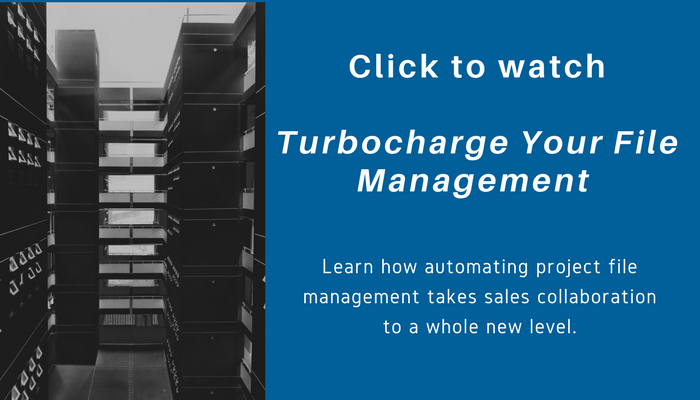 Technology integrators have a very real challenge in managing project files when sales teams collaborate. On any given assignment, team members manage and share numerous files, of different types, like Excel, Word, Visio, PowerPoint, and PDF. But there’s hope for your team. Based on our work with numerous clients over the years, we’ve gathered our top four “best practices” approaches to file management that will make the process more effective and efficient for you.
Technology integrators have a very real challenge in managing project files when sales teams collaborate. On any given assignment, team members manage and share numerous files, of different types, like Excel, Word, Visio, PowerPoint, and PDF. But there’s hope for your team. Based on our work with numerous clients over the years, we’ve gathered our top four “best practices” approaches to file management that will make the process more effective and efficient for you.
Four Best Practices of File Management
- Centrally store your project files. Because projects generally are collaborative and involve several team members, it’s important to set up the folder structure in a shared location that can be accessed by multiple people, rather than on an individual’s hard drive. These days, there are numerous ways to do that, including:
• Saving directly to the shared network location, although this is “manual” and requires that the user is online with the shared location.
• Syncing applications like Windows Sync or Microsoft OneDrive that set up a “network folder” on each user’s hard drive that is then synced to the shared location.
• Using copy applications like Second Copy that copy local folders to shared folder locations when the user is “online” with the shared folder location.
• Implementing cloud-based “network drive” services such as DriveHQ that enable users to save files to a mapped drive without requiring them to be on the corporate network. The cloud-based drive can be used in conjunction with an automated copy application (like Second Copy) or an application that auto-pushes local files to the cloud drive.
• File sharing applications like Microsoft SharePoint. - Create an organized folder structure. The folder structure for project files should be logical and easy to navigate. We suggest CUSTOMER NAME at the top level, and PROJECT NAME, PROJECT ID or OPPORTUNITY ID (from your CRM system) at the next level. The Customer Name should be the “short” version of the customer’s name (“Acme” instead of “Acme Corporation”) and you should have some means (and a tracking system) for ensuring consistency in how customers are named so that you don’t have multiple folders for the same company. If your company needs to restrict folder access by user, you might consider inserting USERNAME a level above CUSTOMER NAME in your folder structure. A sample folder on a shared S: drive might be S:JoeSmithAcmeID1465.
- Use file naming conventions. As with the folder naming structure, we recommend inserting the “short” version of the CUSTOMER NAME as part of the file name, followed by PROJECT NAME, PROJECT ID or OPPORTUNITY ID , then SITE NAME (if you create multi-site solutions), then FILE TYPE (“Quote”, “Proposal”, etc.) and finally VERSION NUMBER. A sample file name might be Acme-ID1465-Boston-Quote-V1.xlsx.
- Back up your project files. If your folder structure is created in a shared location, most likely that location is being backed up on a daily basis, if not more frequently. If you are saving project files to local hard drives, it’s imperative that you set up automated backup software that backs up project (and other) files to another location. Either way, we recommend using backup software like Second Copy that runs several times per day – and incrementally backs up new and changed files – so that you lose no more than a couple of hours of work if there’s a hard drive catastrophe. Backing up sounds like common sense, but it’s shocking how many companies are not doing it properly!!
Using Automation for Collaboration
SalesDoc Architect (SDA) – CorsPro’s configuration, pricing and document generation solution – has long automated the process of naming quote files and saving them to a folder structure, including auto-creating folders according to a client-defined folder schema. Users of SDA know that it automates folder and file management by automatically naming and saving files according to a client-defined file naming schema. We’re also able to push files that have been saved “offline” to a central file location when the user is back “online”.
If the network is not available, we provide an option to save those quote files to the user’s local drive. The shortcoming of this approach is that if the user is offline and the files are saved to their local drive, the user either needs to manually copy the files to the shared network location or a sync process has to be set up to automatically copy the files to the network location. Our offline/online file management functionality has enabled us to overcome this issue.
With our offline/online file management functionality:
- Quote files are always auto-saved to the local drive (i.e., they’re never saved directly to a network location), meaning that file saving is always very fast.
- When the user is “online” with the network location, SDA will copy the file to the network location and auto-create folders (if necessary) based on the client-defined folder schema.
- When the user closes the locally-saved file, SDA will DELETE that file from the local drive, ensuring that there is only ONE copy of the file (i.e., in the network location).
Many solutions only allow simple quote files to be saved. However, we’ve engineered SalesDoc Architect to auto-save OUTPUT files (e.g., proposals and scopes of work) in the same way that quote files can be auto-saved. Just like quote files, output files (Excel, Word and PDF) will be transferred from the user’s local drive – where they’re initially saved – to the shared network location.
Easier Collaboration Results in More Profitable Sales
Successful sales teams are just that – a TEAM. Sales and sales engineers are all on the same team and ultimately have the same goal – make their company profitable with satisfied customers and jobs implemented correctly with a minimum of change orders that lead to scope creep and lower margins.
The benefits of the offline/online file management functionality are numerous. You can:
- Instantaneously auto-save quote and output files. No more typing in file names or searching for (or creating) the folders into which the files are saved.
- Auto-save all quote and output files in logical project folders. Now you can find all project-related files in one place.
- Share project files with other team members – rather than storing them on local hard drives – so that team members can collaborate on the project files.
- Open quote files via SDA Cloud, assuming the user has access to the corporate network drive or cloud-based drive where the quote files are stored.
- Maintain a single set of quote and output files in the shared file location.
As an SDA user and administrator setting up the offline/online file management functionality isn’t difficult nor time-consuming. Simply install or update SDA Cloud services on user PCs, then define your automatic file-saving scheme.
Following any or all of these best practices will result in a streamlined pre-sales process. Automate them for even greater results.
For more information on this blog post or any other CorsPro functionality, send us an email.
